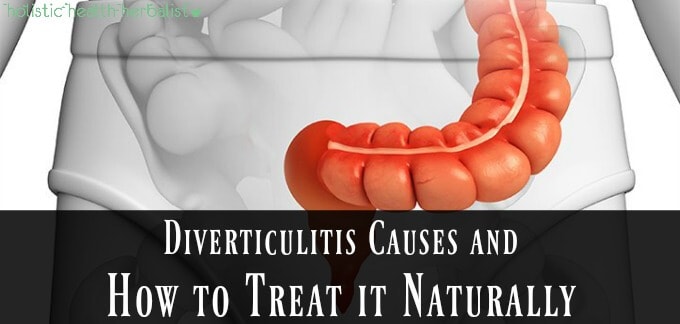In the United States alone, there are over 200,000 people per year who are hospitalized for diverticulitis. Approximately 10 percent of American adults over the age of forty develop this condition, which leads to the development of marble-sized bulges or pouches in the intestinal lining. These bulges, called diverticula, can become painful and inflamed, and, in severe cases, can lead to hospitalization or the need for diverticulitis surgery. (source)
So, what are the causes of diverticulitis, and how can we treat this debilitating condition naturally?
What is Diverticulitis and Diverticulitis Causes
Diverticulitis is an inflammatory bowel condition where the lining of the colon develops pouches, sacs or bulges.
They most often occur in the lower area of the colon called the sigmoid colon and can become painful and inflamed due to their structural weakness and affinity for harboring fecal matter and bacteria. (source)
When these pouches are under pressure, like when you’re constipated for example, or if you eat a food that irritates your gut, tiny tears and areas of inflammation can occur in the intestinal lining within the pouches.
It is these little tears and reactions to the food you shouldn’t eat that become infected and inflamed, therefore resulting in diverticulitis. (source)
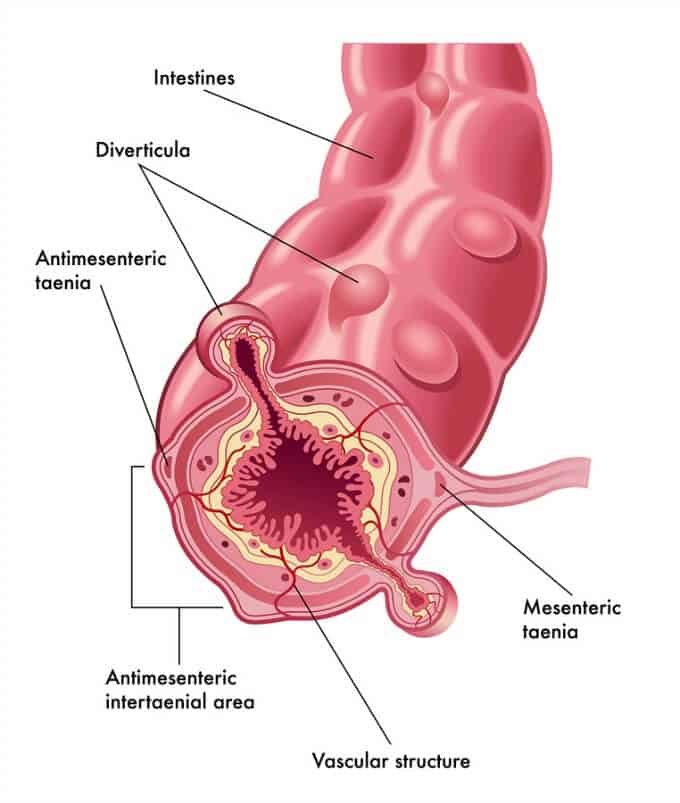
Diverticulitis vs Diverticulosis
Believe it or not, the terms diverticulosis, diverticulitis, and diverticular disease are often used interchangeably.
However, the term diverticulosis only refers to the presence of pouches in the colon, while diverticulitis refers to the presence of inflammation and infection within the pouches.
Diverticular disease refers to the full onset of symptoms related to these conditions.
What Causes Diverticulitis?
The emergence of diverticulitis seems to correlate with the introduction of processed foods within the American diet.
Diet and genetics, among other risk factors in your day-to-day life, play a huge role in whether or not you develop diverticulitis, especially as you get older.
In fact, it is believed that over half of Americans over the age of 60 (among these being predominantly women) have some degree of diverticulitis and/or diverticulosis.
The root cause of both conditions stem from the following:
- A low-fiber diet (less than 30g per day)
- An imbalance in intestinal flora
- Food sensitivities and intolerances
- Lack of exercise
- Frequent straining while using the bathroom (this puts pressure on the bowels and abdominal cavity, which can contribute to pocket formation in the intestinal walls)
Symptoms of diverticulosis include:
- Almost no symptoms, merely the presence of pouches or sacs along the walls of the colon
- Some may experience lower abdominal discomfort, constipation, and bloating
Symptoms of diverticulitis include:
- Bloating
- Change in bowel habits
- Chills
- Constipation
- Cramping
- Diarrhea
- Fever
- Mild abdominal pain that gets worse over time
- Nausea and vomiting
- Rectal bleeding
- Sudden pain that can be severe in the lower left side of the abdomen
- Tenderness in the lower abdomen
The symptoms of diverticulitis flare-up usually include a number of the above, most often pain in the lower left abdominal region.
Although the majority of patients with diverticulitis do not exhibit any symptoms, 10-25% of those with the condition will develop symptoms ranging from recurrent short-lived pain to significant abdominal discomfort with fever and increased leukocytes (white blood cells) that requires hospitalization.
It is when the pouches along the colon become blocked with fecal matter, allowing bacteria to flourish, that this can result in infection and inflammation.
Symptoms of Severe Diverticulitis Include:
- Pain, which may be constant and persist for several days. The lower left side of the abdomen is the usual site of the pain.
- Nausea and vomiting
- Fever
- Abdominal tenderness
- Constipation or, less commonly, diarrhea
Other risk factors for developing diverticulitis include:
- A diet high in red meat and fat and low in fiber
- Certain medications including the use of NSAIDs
- Lack of physical activity or a sedentary lifestyle
- Obesity
- Smoking
In rare cases, those with diverticulitis may develop more serious complications.
Complications of diverticulitis include:
Abscess – severe pain and tenderness in the lower abdomen due to an inflamed, infected, pus-filled lesion just outside of the colon that makes you feel ill. Symptoms may also include fever, nausea, and vomiting.
Fistula – an abnormal passage between two organs like the colon to the bladder, etc.
Intestinal obstruction – a complete blockage of fecal matter in the intestine
Perforation – small tears in the diverticula pouches lining the colon
Peritonitis – an infection that leaks through the tears within the diverticula and into the lining of the abdomen
These conditions stem from having acute diverticulitis which is why it is so important to get tested and begin treatment.
Whatever the case may be, whether it’s a mild episode of diverticulitis (even thinking it might just be a flare up of irritable bowel syndrome), it’s important to begin an all liquid diet (clear liquids) in order to stop a diverticulitis flare from getting worse.
How to Get Tested for Diverticulitis
If you feel like you have any of the above symptoms, it is a good idea to speak with your doctor so that they can perform a few tests to see if diverticulitis is the culprit.
Testing techniques include:
- A physical exam (called a colonoscopy) of the abdomen is used to reveal tender areas, especially in the lower left abdomen. This is done using a colonoscope, a flexible tube with a camera at the end inserted into the rectum
- Blood work to see if there are increased levels of white blood cells
- Stool analysis to test for flora, inflammation, blood (from diverticular bleeding), and bacterial or fungal overgrowth
- A CT scan to look for infected or inflamed diverticula
- A barium enema x-ray to confirm the presence of diverticula
Conventional Treatment for Diverticulitis
In mild cases, a flare is treated with antibiotics along with the recommendation to consume a liquid diet for a few days until symptoms improve.
In more severe cases, steroids, opioids, powerful antibiotics, and anti-inflammatories will be prescribed.
In VERY severe cases, surgery may be needed based on diagnosis and severity of symptoms.
How to Treat Diverticulitis Naturally
Diet for Diverticulitis
With the abundance of low-cost processed foods in the Standard American Diet and the astoundingly low intake of healthy fibrous foods, it’s no surprise that the number of people who develop diverticulitis continues to rise.
Research suggests that eating a diet high in fresh fruits and vegetables has the most protective effect against diverticulitis, in fact, those who eat 30 grams of fiber or more per day have been shown to have a 42% less chance of developing diverticulitis than those on low-fiber diets.
Staying properly hydrated is also key in preventing constipation and bowel obstruction from inflammation in the bowels that refuses to go down, so make sure to drink enough water daily.
One way to drink plenty of fluids every day is to add fresh fruit or cucumber slices to your daily water for flavor.
Here’s How to Eat Properly for Diverticulitis
1. Up your fiber intake to 20-30 grams per day
To treat and prevent diverticulosis and, in turn, diverticulitis, it is recommended to consume a high-fiber diet that focuses on fresh fruits and vegetables and whole grains – preferably grains like quinoa and well-cooked brown rice.
It’s also important to get both soluble and insoluble fiber into your diet.
Soluble fiber retains water and gels up during the digestive process which helps slow digestion and allows for the better absorption of nutrients from our food.
Foods high in soluble fiber include nuts, seeds (like flax and chia), beans, lentils, peas, and barley.
Insoluble fiber adds bulk to stools and helps food and waste move smoothly through the digestive tract.
Foods high in insoluble fiber include whole grains and vegetables.
Research shows that it is insoluble fiber that lowers the risk for diverticulitis, so make sure to eat an abundance of fresh fruits and vegetables daily.
2. Eat more probiotic-rich foods
Eating fermented foods like kefir, activated yogurt, sauerkraut, kimchi, miso, natto, and kombucha are also great ways to establish diverse intestinal flora naturally.
These good bacteria help negate food sensitivities and can even help prevent constipation, gas, and bloating, which is important for keeping the walls of the colon free of inflammation.
It is especially important to eat probiotic foods daily if you have needed antibiotics in the past for a flare. This will help rebuild your intestinal flora.
3. Avoid inflammatory foods and drink
Cutting processed low-fiber foods from your diet is key to keeping inflammation out of the body.
Other foods, like dairy products, gluten, and red meat are known to increase inflammation within the gut and should either be avoided or consumed infrequently in small quantities.
Other foods to avoid with diverticulitis include any food allergies or intolerances you have as this flares inflammation in the gut.
What about diverticulitis and alcohol?
I know it’s tempting to drink a beer on the weekends or have that glass of wine after work, but if you have diverticulitis, you would be better off avoiding it as much as possible as it’s highly inflammatory.
This includes soft drinks as well.
The bottom line is, alcohol and soft drinks are huge contributing factors to a flare.
The Diverticulitis Diet for Flare-Ups
Sometimes, despite your best efforts, a flare-up can be triggered no matter what you do.
When a sudden flare-up happens, it’s crucial to get the inflammation and infection in the gut under control.
During this process, it’s a good idea to keep a food journal so that you can seamlessly treat any future flare ups and be prepared for them.
Stage One
As soon as you feel symptoms, you need to begin a liquid-only diet to help flush out the diverticula and reduce inflammation so that they can heal.
Drinking bone broths rich in natural gelatin is extremely healing for the gut lining, most especially if made at home.
You can make very simple yet tasty soups by simmering some fresh vegetables and a few chicken legs to create a wholesome broth filled with vital nutrients that are easy to digest.
Strain the broth and drink it three or more times daily for 2-3 days while symptoms dissipate.
You can learn how to make bone broth here.
Some people tolerate eggs well, so you may want to try making an egg drop soup or simply poach an egg in the broth to provide a little more substance, but don’t overdo it. Listen to your body.
Fresh ginger can also greatly help settle the gut and reduce inflammation in the bowels. To use it, either simmer it in homemade broth or make a strong tea. Drink three times daily.
Stage Two
Once symptoms have eased, you can begin to slowly incorporate easily digestible foods like steamed vegetables and pureed fruits.
It is super important to chew your food very well during this time to make digestion as easy as possible. Failing to do so may result in another flare during the healing process.
You can also consume fruit and or vegetable juices with some of the pulp.
Stage Three
Once you feel more like yourself, you can then incorporate fiber-rich foods like unrefined grains, whole fruits and vegetables, and even sprouted lentils.
If you experience any returning symptoms, fall back on the previous stage for a few more days.
Stage Four
This is the last stage where you can begin to eat more fibrous foods like sweet potatoes, potatoes, and other root vegetables. You can also begin to experiment with other grains and beans.
Continue to document the foods you eat, when you ate them, and you felt after.
Once you feel normal again without any symptoms, you can go ahead and slowly reincorporate regular foods back into your diet but pay close attention to how you’re feeling when you eat those foods.
The Best Supplements for Diverticulitis
To prevent diverticulitis symptoms altogether, it’s a good idea to add a few helpful supplements into your daily routine.
Supplements for diverticulitis include:
- Chamomile tea – reduces intestinal inflammation and calms digestion.
- Colloidal silver – extremely helpful during a flare-up and can help fight off infection
- DGL Licorice – 300mg per day twenty minutes before meals to help lubricate and calm the digestive tract and reduce inflammation in the colon.
- Digestive enzymes – take 1-2 capsules of digestive enzymes before every meal to help your body digest foods more completely.
- Ginger tea – reduces inflammation, gas, bloating, and stomach upset.
- High-quality aloe vera juice – soothes and heals the intestinal lining
- Oil of oregano – can be taken to help fight off infection during a flare.
- Peppermint tea – alleviates digestive upset like bloating and gas. Aids indigestion.
- Probiotics – take 20-50 billion active strains daily to help fight infection and prevent inflammation, constipation, bloating, and gas. Those with diverticulosis can take 5 billion per day to maintain healthy gut flora.
- Psyllium fiber – a form of insoluble fiber that helps bulk up stools and prevent flare-ups.
- Slippery elm – soothes and protects the mucous membranes of the colon and reduces inflammation.
It never hurts to have some aspirin or ibuprofen around the house for discomfort.
Homeopathy for Diverticulitis – The Best Homeopathic Remedy for Diverticulitis
Homeopathic remedies can be taken at a 30C potency to help alleviate symptoms of diverticulitis.
Take the remedy that fits your symptoms 4x daily for 2-3 days to see if there is any improvement. If there is an improvement, you can stop taking the homeopathic remedy unless symptoms return.
Arsenicum Album
Arsenicum Album is for burning pain in the abdomen that is relieved by heat. This may be accompanied by feelings of anxiety and restlessness.
Bryonia Alba
Bryonia Alba is for sharp pains in the left side of the abdomen that becomes worse with movement.
Belladonna
Belladonna is for abdominal throbbing or burning pain that is sudden accompanied by a fever. The pain is worse with movement.
Colocynthis
Colocynthis is for sharp, gassy, colicky pain in the abdomen that is relieved by pressure.
Ignatia Amara
Ignatia Amara is for spasms in the colon that occur after emotional stress.
Magnesia Phosphorica
Magnesia Phosphorica is for abdominal cramping that is relieved by heat but worse with pressure.
Nux Vomica
Nux Vomica is for cramping pain in the digestive tract accompanied by irritability and chill extremities.
Sulphur
Sulphur is for those who are awakened by diarrhea that is urgent.
Acupressure for Diverticulitis
Conception Vessel 6 (CV6) – alleviates gas and diarrhea
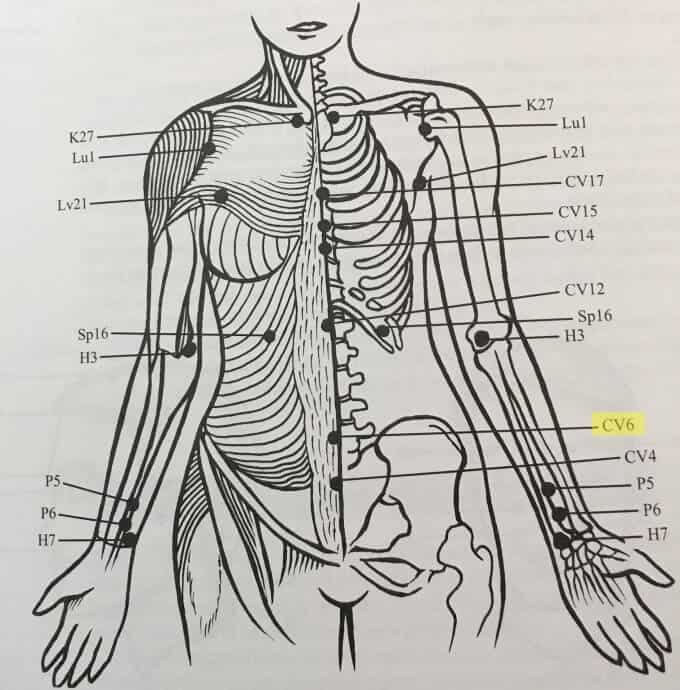
Large Intestine 11 (LI11) – Improves the strength of the colon
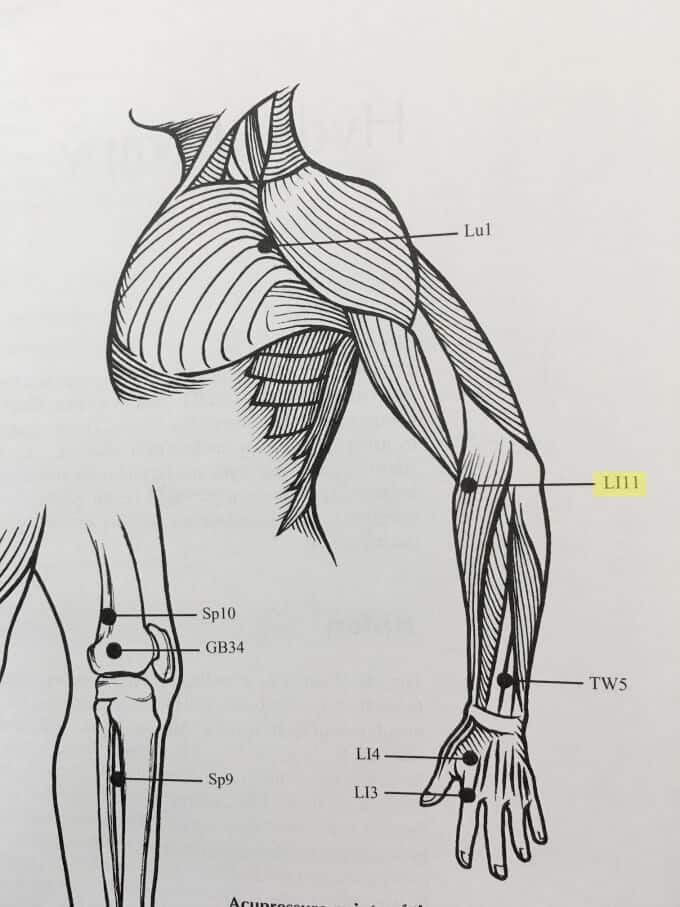
Spleen 16 (Sp16) – alleviates abdominal cramps
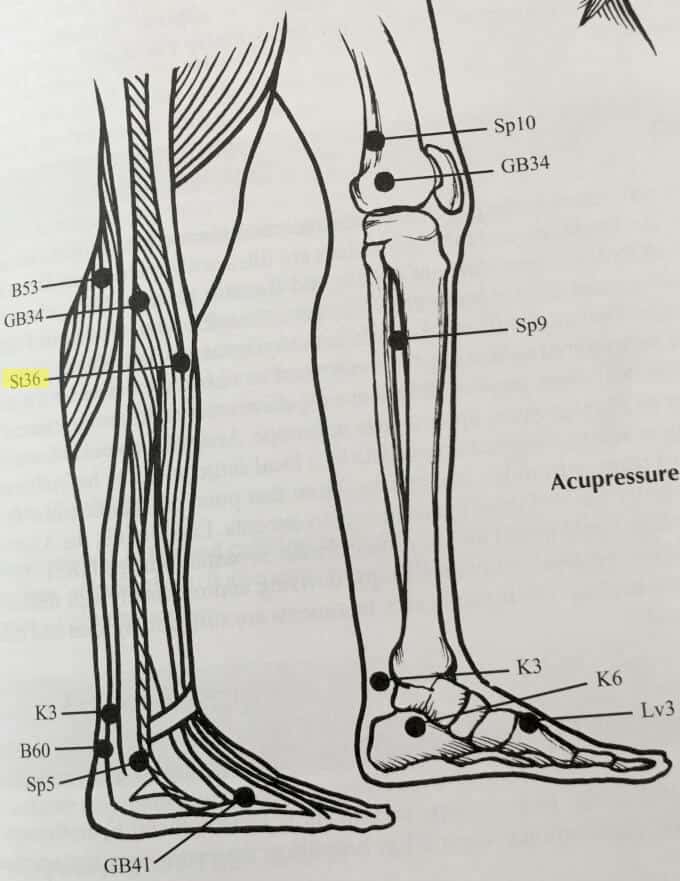
Stomach 36 (St36) – to aide the assimilation of nutrients
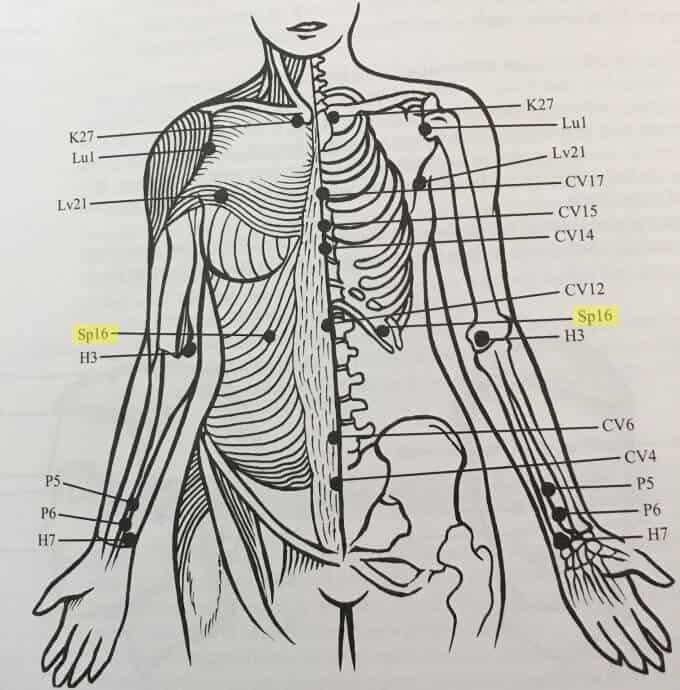
Essential Oils for Diverticulitis
Essential oils for diverticulitis can be diluted in carrier oil and applied to the abdomen before or after meals or during a flare-up to help prevent or alleviate symptoms of gas, bloating, constipation, or cramping.
Try a dilution of 2 drops in 1tsp of carrier oil and apply it over the abdomen.
- Anise – use before or after meals to aid digestion
- Fennel – great for use before and after meals to prevent or treat gas and bloating
- German chamomile – Great for reducing pain and inflammation
- Ginger – warming and soothing for cramps
- Nutmeg – warming and soothing. Good for aiding digestion (dilute very well, 1 drop per 1tsp)
- Patchouli – great to use on the abdomen to prevent nausea and vomiting
- Peppermint – cooling and soothing for cramps
Frequently Asked Questions About Diverticulitis
Why am I so tired with diverticulitis?
There are several reasons why you may feel tired with diverticulitis, these include:
- Pain and discomfort – Diverticulitis can cause pain and discomfort in the abdomen, making it difficult to get a good night’s sleep. This can lead to fatigue and tiredness during the day.
- Inflammation – Diverticulitis is an inflammatory condition, and the inflammation can cause the body to release cytokines, which are proteins that can cause fatigue and a feeling of general malaise.
- Dehydration – Diarrhea, vomiting, and a decreased appetite can cause individuals with diverticulitis to become dehydrated, leading to a lack of energy and feelings of tiredness.
- Medication side effects – Antibiotics are commonly used to treat the infection associated with diverticulitis, and these medications can cause various side effects, including fatigue and drowsiness.
- Surgery recovery – If an individual requires surgery to treat their diverticulitis, the recovery process can be long and may require bed rest, leading to feelings of fatigue and exhaustion.
- Nutrient deficiencies – Individuals with diverticulitis may be at risk of nutrient deficiencies, such as iron deficiency anemia, which can cause fatigue and tiredness.
- Emotional stress – Dealing with a chronic health condition like diverticulitis can be stressful and emotionally draining, leading to feelings of fatigue and exhaustion.
How diverticulitis is diagnosed?
Diverticulitis is typically diagnosed through a combination of medical history, physical examination, and diagnostic tests.
Some of the methods used to diagnose diverticulitis include:
Medical history – The healthcare provider will ask you about your symptoms, medical history, and family history. They may ask about your bowel movements, diet, and any medications you are taking.
Physical examination – The healthcare provider will perform a physical examination, including checking your abdomen for tenderness, bloating, or swelling.
Blood tests – Blood tests can help determine if there is an infection or inflammation present in your body. They may also be used to check your white blood cell count, which can indicate the severity of the infection.
Stool sample – A stool sample may be taken to check for the presence of bacteria or other signs of infection.
Imaging tests – Imaging tests can help to confirm a diagnosis of diverticulitis and identify any complications.
Imaging tests include:
CT scan – A CT scan is a type of X-ray that creates detailed images of the colon and surrounding tissues. It can show the presence of diverticula and any inflammation or abscesses.
Ultrasound – An ultrasound uses sound waves to create images of the colon and surrounding tissues. It can show the presence of diverticula and any complications such as abscesses or blockages.
MRI – An MRI uses a magnetic field and radio waves to create detailed images of the colon and surrounding tissues. It can show the presence of diverticula and any inflammation or abscesses.
Once a diagnosis of diverticulitis is confirmed, your doctor may recommend a course of antibiotics to treat the infection.
Dietary changes, such as increasing fiber intake, may be recommended to help prevent future episodes of diverticulitis.
In very severe cases, surgery may be necessary to remove the affected portion of the colon.
Diverticulitis what foods to avoid?
- High-Fiber Foods – While a high-fiber diet is recommended for the prevention of diverticulitis, it is not recommended during an acute flare-up. High-fiber foods such as whole grains, nuts, seeds, and raw vegetables can be difficult to digest and may cause further inflammation and irritation in the digestive tract.
- Spicy Foods – Spicy foods can be irritating to the digestive tract and can cause abdominal pain and discomfort, which can worsen diverticulitis symptoms.
- Fatty Foods – High-fat foods such as fried foods, fatty cuts of meat, and full-fat dairy products can be difficult to digest and may exacerbate symptoms of diverticulitis.
- Red Meat – Red meat can be high in fat and can take longer to digest, which can lead to discomfort and worsening of symptoms in individuals with diverticulitis.
- Refined Carbohydrates – Refined carbohydrates such as white bread, pasta, and sugary foods can cause spikes in blood sugar levels, which can worsen inflammation and diverticulitis symptoms.
- Alcohol and Caffeine – Alcohol and caffeine can irritate the digestive tract and cause dehydration, which can exacerbate symptoms of diverticulitis.
What does a diverticulitis attack feel like?
Diverticulitis is an inflammatory condition of the colon that occurs when small pouches in the lining of the colon become inflamed or infected.
The symptoms of a diverticulitis attack can vary in severity, but they typically include:
- Abdominal Pain – The most common symptom of diverticulitis is abdominal pain, which is usually felt on the left side of the lower abdomen. The pain can range from mild to severe and may be accompanied by cramping or bloating.
- Fever – A fever is a common symptom of diverticulitis, especially if the infection is severe. The fever may be low-grade or high-grade and is usually accompanied by chills or sweating.
- Nausea and Vomiting – Some people with diverticulitis may experience nausea and vomiting, which can be caused by inflammation or infection in the colon.
- Changes in Bowel Habits – Diverticulitis can cause changes in bowel habits, such as diarrhea or constipation. Some people may also experience a feeling of incomplete bowel movements.
- Bloating and Gas – Diverticulitis can cause bloating and gas, making the abdomen feel full and uncomfortable.
- Fatigue – Diverticulitis can cause fatigue and a general feeling of malaise, which may be caused by inflammation and infection in the colon.
What triggers diverticulitis?
The exact cause of diverticulitis is not fully understood, however several factors are known to trigger an attack or contribute to the development of the condition.
Common triggers of diverticulitis include:
- Low-Fiber Diet – A diet that is low in fiber and high in processed foods can contribute to the development of diverticulitis. A low-fiber diet can lead to constipation, which can cause increased pressure on the colon, leading to the development of diverticula.
- Aging – The risk of diverticulitis increases with age, and the condition is more common in people over the age of 50.
- Obesity – Being overweight or obese can increase the risk of developing diverticulitis, as the extra weight puts pressure on the colon and increase the risk of inflammation.
- Lack of Exercise – A sedentary lifestyle can contribute to the development of diverticulitis, as regular exercise can help promote bowel regularity and reduce inflammation in the colon.
- Smoking – Smoking can increase the risk of diverticulitis and worsen the symptoms, as smoking can lead to inflammation and damage to the colon.
- Genetics – There may be a genetic component to the development of diverticulitis, as the condition tends to run in families.
- Medications – Certain medications, such as nonsteroidal anti-inflammatory drugs (NSAIDs), can increase the risk of diverticulitis.
What is the leading symptom of diverticulosis?
The leading symptoms of diverticulitis include:
- Abdominal Pain – This is the leading symptom of diverticulosis, although it is not always present. The pain is usually felt in the left lower abdomen and can be mild or severe. It may also be accompanied by bloating or cramping.
- Changes in Bowel Habits – Some people with diverticulosis may experience changes in their bowel habits, such as constipation or diarrhea. Others may experience a feeling of incomplete bowel movements or the need to strain during bowel movements.
- Bleeding – In rare cases, diverticulosis can cause bleeding from the rectum, which may be bright red or maroon in color.
What is the best thing to do when you have diverticulitis?
If you are experiencing symptoms of diverticulitis, it is important to seek medical attention right away. However, if your symptoms are mild, you can look into natural alternatives for relief.
Here’s what you can do to manage your symptoms:
- Rest and Hydration – Diverticulitis causes abdominal pain and discomfort, so it is important to rest and avoid strenuous activity. Drink plenty of fluids, such as water and herbal tea, to stay hydrated.
- Antibiotics – If you are diagnosed with diverticulitis, your doctor may prescribe antibiotics to treat the infection and reduce inflammation in the colon. Be sure to supplement with probiotics afterward.
- Pain Relief – Over-the-counter pain relievers, such as acetaminophen or ibuprofen, may help relieve mild to moderate pain. However, avoid using nonsteroidal anti-inflammatory drugs (NSAIDs), such as aspirin or naproxen, as they can worsen symptoms and increase the risk of bleeding. A heat pad works well for pain.
- Dietary Changes – A low-fiber or liquid diet for a few days during a flare will allow your digestive system to rest and reduce inflammation. Once your symptoms improve, you can gradually reintroduce high-fiber foods, such as fruits, vegetables, and whole grains, to your diet.
- Follow-up Care – It is important to follow up with your doctor as recommended to monitor your progress and prevent complications. They may recommend additional testing or follow-up appointments to ensure your symptoms are improving and to adjust your treatment plan if needed.
How long does a diverticulitis flare-up last?
The duration of a diverticulitis flare-up can vary from person to person and depends on the severity of the condition.
In general, mild diverticulitis flare-ups may last a few days to a week, while a more severe flare-up may last several weeks or longer.
The treatment plan for diverticulitis may also affect the duration of a flare-up. If diagnosed and treated promptly with antibiotics and rest, symptoms may improve within a few days to a week.
However, if left untreated or if complications develop, such as abscesses or perforations, hospitalization and possibly more intensive treatment may be required, which can prolong the duration of the flare-up.
It is important to note that even after symptoms improve, it is still important to follow a healthy diet and lifestyle to prevent future flare-ups.
Your doctor may recommend a high-fiber diet, regular exercise, and other lifestyle changes to help manage the condition and prevent recurrent flare-ups.
Does apple cider vinegar kills diverticulitis?
The acetic acid found in raw apple cider vinegar has been shown in studies to reduce inflammation anywhere from 30% up to 100% in the digestive tract.
How to make a diverticulitis apple cider vinegar drink:
Adding a tablespoon to 8 oz of water and drinking it 2-3 times daily is an effective way to boost digestion and stay hydrated which is important when dealing with a diverticulitis flare.
Raw apple cider vinegar may also help kill off the bacteria causing a flare. However, it is highly recommended to see a doctor if symptoms feel severe. Diverticulitis flares are serious and must be monitored.
Can diverticulitis cause a positive cologuard test?
Yes, it is possible for diverticulitis to cause a positive Cologuard test. Cologuard is a noninvasive colorectal cancer screening test that detects DNA mutations and blood in the stool. Diverticulitis, which is inflammation of the diverticula in the colon, can cause bleeding and changes in the stool that may result in a positive Cologuard test.
However, it is important to note that a positive Cologuard test does not necessarily mean that a person has colon cancer. There are many reasons why a Cologuard test may be positive, including non-cancerous conditions such as diverticulitis or hemorrhoids. If you have a positive Cologuard test, your healthcare provider may recommend additional testing, such as a colonoscopy, to further evaluate the results and determine the appropriate next steps for your care.
Can stress cause diverticulitis?
Stress alone does not directly cause diverticulitis, but it can contribute to the development or exacerbation of the condition in some people. Diverticulitis is primarily caused by the formation of small pouches or diverticula in the colon that become inflamed or infected. These pouches can develop due to various factors, including age, diet, genetics, and lifestyle habits.
However, stress can impact the digestive system in various ways, like increasing gut motility, altering gut bacteria, and affecting the immune system. These changes can potentially worsen symptoms of diverticulitis or trigger an inflammatory response in the colon.
Stress can also indirectly contribute to the development of diverticulitis by leading to poor lifestyle habits, such as a diet high in processed foods and low in fiber, lack of exercise, and poor sleep habits. These lifestyle factors can increase the risk of developing diverticulitis.
Can diverticulitis cause hip and leg pain?
It is possible for diverticulitis to cause hip and leg pain, but it is not a common symptom of the condition.
However, in some cases, the inflammation or infection associated with diverticulitis can spread to other parts of the body, leading to symptoms such as hip and leg pain. This can occur if the inflamed diverticula are located near the pelvis or if the infection spreads through the bloodstream.
Can diverticulitis cause cancer?
Diverticulitis itself does not cause cancer, but chronic inflammation and infection of the diverticula in the colon can increase the risk of developing colon cancer. Diverticulitis is an inflammation or infection of the diverticula, which are small pouches that can develop in the colon. These pouches can become inflamed or infected due to various factors, including age, diet, genetics, and lifestyle habits.
Chronic inflammation of the colon has been linked to an increased risk of developing colon cancer. The inflammation can damage the cells lining the colon and lead to the development of abnormal growths called polyps, which can eventually turn into cancer if not treated.
It is important to note that not all cases of diverticulitis increase the risk of colon cancer, and the risk varies depending on factors such as the severity and frequency of the inflammation and infection, as well as individual risk factors such as age, family history, and lifestyle habits.
Can alcohol cause diverticulitis?
While alcohol consumption alone is not a direct cause of diverticulitis, it can contribute to the development or exacerbation of the condition in some people.
Heavy alcohol consumption has been linked to a number of digestive problems, including inflammation of the colon and an increased risk of gastrointestinal infections, which can contribute to the development or worsening of diverticulitis.
Alcohol can also contribute to poor dietary habits, such as consuming a diet low in fiber and high in processed foods, which can increase the risk of developing diverticulitis.
Sources
Prescriptions for Natural Cures Third Edition – Balch, James F., Mark Stengler, and Robin Young Balch. Prescription for natural cures: a self-care guide for treating health problems with natural remedies including diet, nutrition, supplements and other holistic methods. John Wiley & Sons, Inc., 2011.
Essential Oils Pocket Reference Fifth Edition
What have been your tried and true treatments for diverticulitis? Please share them in the comments below!
You may also enjoy reading:
How to Treat “Thrush Tongue” Naturally
My Experience Using uBiome
How to Relieve Gas- The Herbalist’s Way
Essential Oils for Digestion
DIY Digize Essential Oil Blend
The Best Anti-Bloat Essential oils and How To Use Them
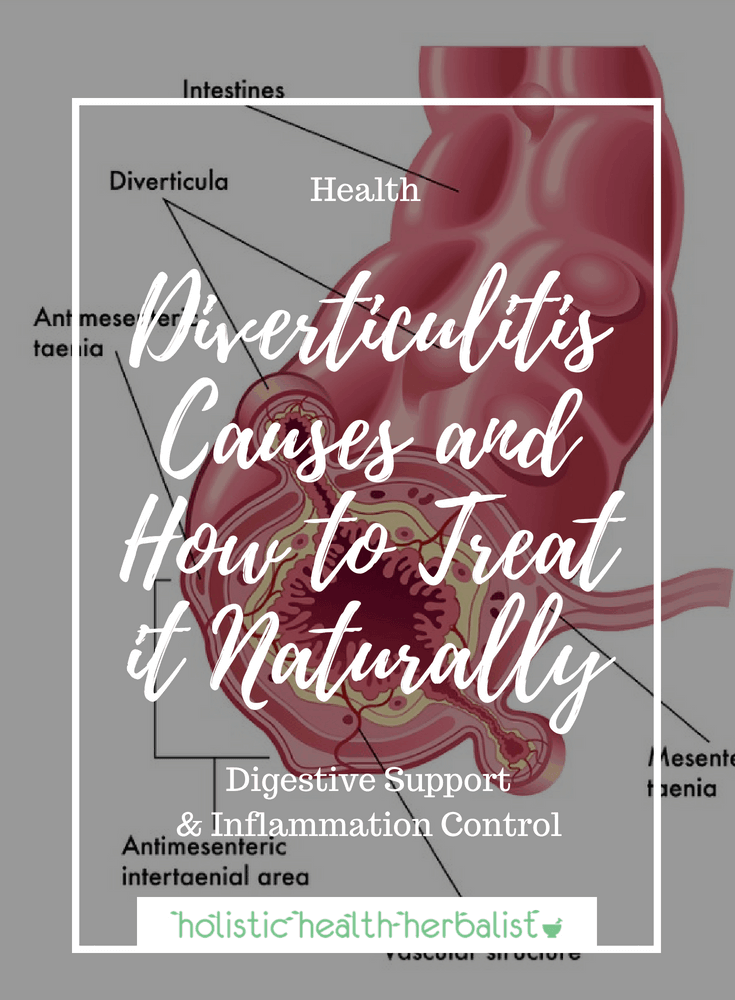
This post contains affiliate links. We are a participant in the Amazon Services LLC Associates Program, an affiliate advertising program designed to provide a means for us to earn fees by linking to Amazon.com and affiliated sites. Read my full disclosure and disclaimer.

